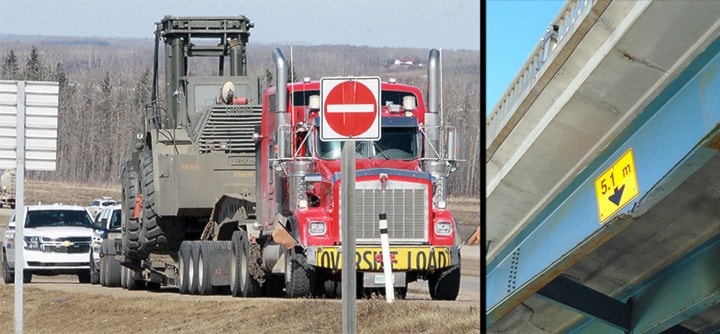Vehicles or oversized loads striking bridges, overpasses or flyovers happens more often than the public knows. And the costs of just one can run into the millions of dollars, which isn’t always recoverable.
However, a pair of recent collisions along Highway 2 near Ponoka has brought the issue to the forefront and the hope is that shedding some light on the situation will reduce the chance of future collisions.
Don Saunders, bridge manager for Alberta Transportation based in Red Deer, stated that there were 30 incidents of bridges being hit across the province since 2010.
“I’m not sure how big the problem is as not every incident is reported,” he said in a phone interview.
“So, to have a couple occur within a few months of each other can be chalked up to being a little bit unlucky.”
The driver of the vehicle is responsible for ensuring a load will go safely under a bridge or overpass and permits are only necessary for loads that are 4.5 metres or higher. However, for some companies such as home movers, they can apply for annual permits on load ranging from 4.15m to 5m in height. Any load that is higher than 5m requires a special individual permit.
“Alberta Transportation issues tens of thousands of permits each year, so to put this into perspective, having this many hits in seven years isn’t a big problem,” he stated.
For vehicles with a permit, a database is used to layout the route that should be used. Though, Saunders added, sometimes even with that information bridge hits still occur mostly due to an error in measuring the load or not paying attention to the signage along the route the driver is travelling.
“Avoiding a strike should be as simple as measuring the load properly, following the route on the permit and turning loads appropriately,” Saunders said.
On the QEII Highway, stretching from Leduc to Crossfield, there have been five overpasses hit in the last three years. Two of those incidents took place south of Red Deer and one at Blackfalds. Meanwhile, the other two were the Louis Bull (Township 455) flyover that was stuck March 29 and the Highway 53 overpass which was stuck back in January.
“The issue with the Highway 53 incident is the overpass had been struck previously as far back as 2014. That one wasn’t reported and we were just about ready to work on the repair when the strike in January took place,” he stated.
“The time it takes for a repair depends on how severe the damage and how long it takes for design and repair plans to be completed. We do seek payment from the carrier responsible, but at times finding that out isn’t possible. As well, we can only recover the direct cost for the repair and for hiring traffic control and those cost are specific to each job.”
In his 16 years in the department, Saunders has seen repairs range from $10,000 up to several million dollars.
“It all depends on the severity of the damage and what kind of lane or road closures have to be put in place,” he said.
“Simple lane closures cost far less than the impact on Highway 2 traffic and the complications involved in setting up to conduct lengthy and major repairs on those overpasses.”
